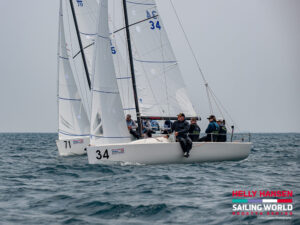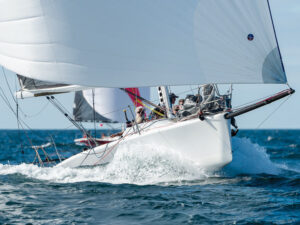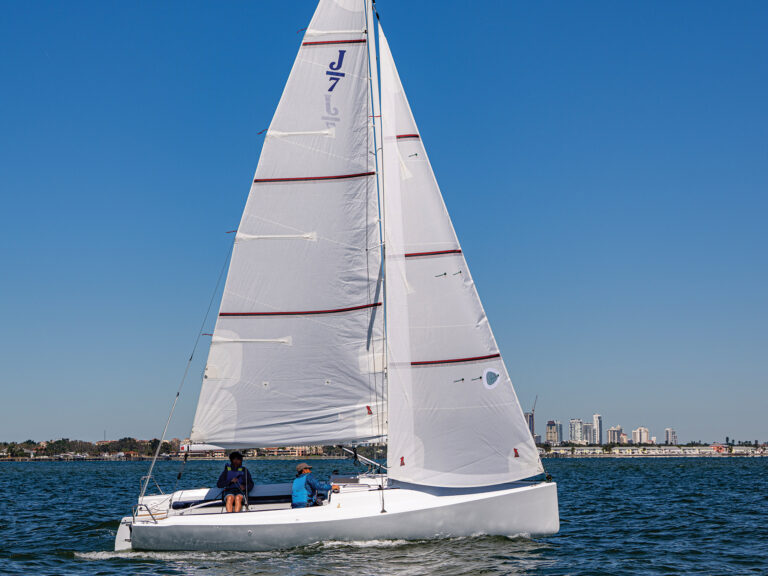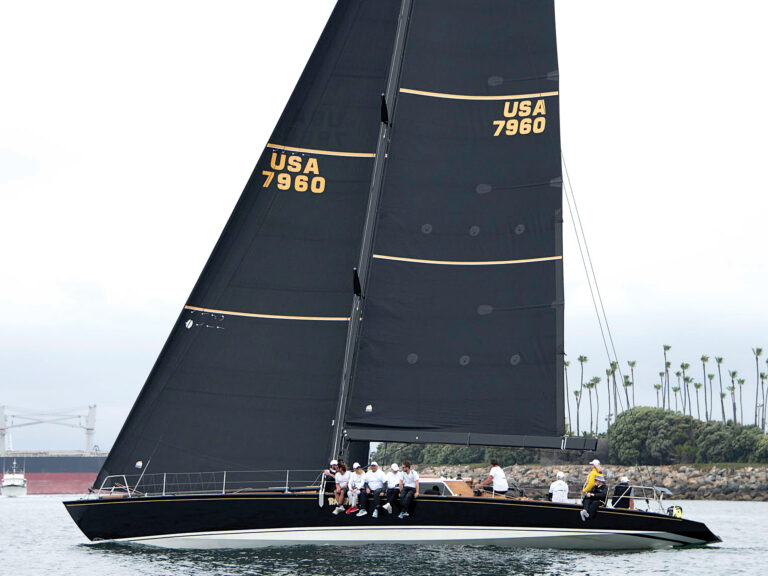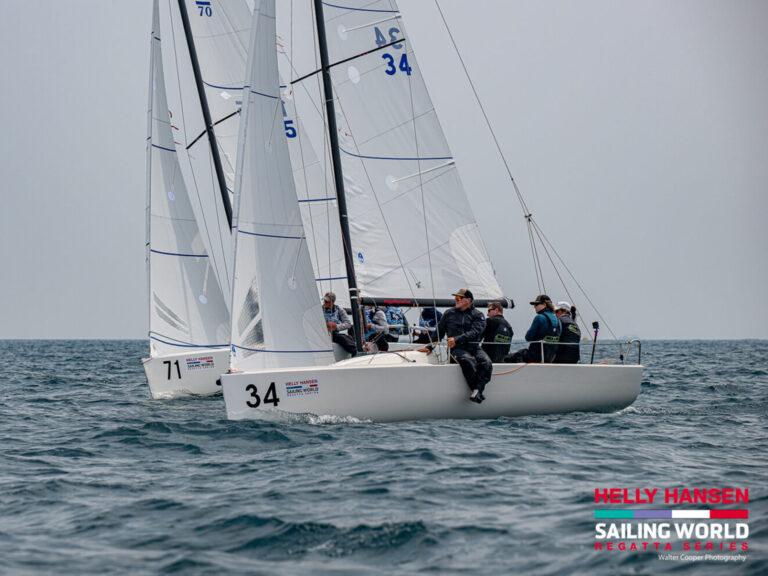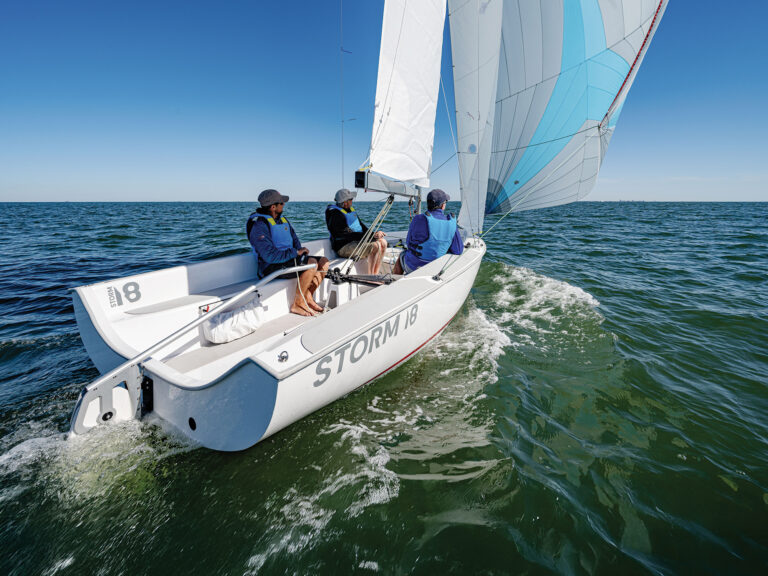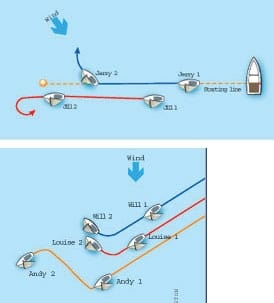
RoseRules0905
I get a lot of e-mail from readers asking about specific rules and situations, and these e-mails help me understand what puzzles racers when it comes to the Racing Rules of Sailing, and recently a few questions revealed confusion about some very basic topics-specifically how luffing tactics and proper course are covered by the rules.One reader wrote about a situation, shown in the first diagram, where the pin end of the starting line was set so far to windward that the boats could barely cross the line on starboard tack. The fleet lined up bow-to-stern on starboard and then, moments after the starting signal, all but two of them tacked onto port. Eventually only Jill and Jerry continued on starboard. Jill couldn’t safely tack across Jerry’s bow and was frustrated when Jerry didn’t tack as soon as he was clear to do so. Jill hailed to Jerry, “Sail your proper course!” But Jerry continued on starboard until Jill was forced to sail past the pin end of the starting line. Jill was sure that Jerry broke a rule by not sailing a proper course and wrote me asking which rule Jerry broke.It’s time to discuss proper course. Words in the rulebook are printed in either normal type or italic type. When a word or phrase, such as proper course, is printed in italics, it is being used in a special technical sense, which you can learn by studying its definition in the Definitions section at the back of the rulebook.Proper course appears in only three rules-Rules 17.1, 17.2, and 18.4. None of these three rules-and indeed no rule in the rulebook-requires a boat to sail her proper course. Rule 17.1 tells some leeward boats not to sail above their proper course; Rule 17.2 tells some windward boats and some clear ahead boats not to sail below their proper course; and Rule 18.4 tells a leeward boat with an inside overlap at a jibe mark not to sail further from the mark than her proper course would take her. According to the definition, a boat’s proper course is the course she “would sail to finish as soon as possible in the absence of the other boats referred to in the rule using the term.”So what rules do apply in the situation shown in the first diagram?As the boat clear ahead, Jill holds right of way under Rule 12. If she tacks, at the moment she turns past head to wind, she will lose right of way and will be subject to Rule 13. Rules 18 and 19 don’t apply because the pin is a starting mark surrounded by navigable water (see Rules 18.1(a) and 19.2). No rule requires Jerry to sail a proper course, and the rules permit him to remain on starboard as long as he wishes.Another query revealed a misunderstanding involving proper course during a simple windward-leeward luffing situation. As shown in the second diagram, while sailing on a broad reach, Will overtakes Louise from clear astern and begins to sail past her to windward. Louise luffs sharply immediately after Will overlaps her. Will is moving faster and, after Louise has turned through about 90 degrees, Will is bow out on Louise and his port quarter is close to her bow (Position 2 in the diagram). Louise is well above her proper course and Will hails, “Sail your proper course!”Will’s hail is about 10 years too late. Under the rules in effect in 1996, Louise was permitted to luff as fast as she wished, even if she made contact with Will, and when the helmsman on Will’s boat reached a point abeam of Louise’s mast, he could’ve hailed “mast abeam,” and Louise would’ve been required to bear away to her proper course.Today, the rules governing this situation are quite different. While Louise is clear ahead of Will, Rule 12 requires Will to keep clear. When Will overlaps Louise on her windward side, the applicable rule becomes Rule 11 (On the Same Tack, Overlapped), but Louise retains right of way as the leeward boat. Rule 15 does not apply when the overlap begins because Louise retains right of way. Rule 17.1 does not limit Louise’s right to luff because Will overlapped Louise on her windward side. Because Rule 17.1 does not apply, Louise may sail any course she wishes even if that course is not her proper course. However-and this is a big difference between the 1996 rules and the current rules-whenever Louise changes course she must give Will room to keep clear (see Rule 16.1).Between positions 1 and 2, neither boat breaks a rule. Rule 11 requires Will to keep clear, and he has done so because at no time did Louise need to take action to avoid him and at all times she was able to change course, either by luffing or bearing away, without immediately making contact with him (see the definition Keep Clear). Rule 16.1 requires Louise to give Will room to keep clear as she luffs, and she does so because he has the space needed to keep clear by maneuvering promptly in a seamanlike way (see the definition Room).At position 2, Will is bow out on Louise and his port quarter is quite close to her bow-a position that some people call the “lock up” because neither boat can luff any higher without risk of touching the other. If Louise were to luff higher, her bow would swing toward Will’s stern, and if Will tried to luff in response his stern would swing toward her bow. If Louise did luff higher at position 2 she would’ve broken Rule 16.1 by failing to give Will room to keep clear.Louise’s luffing tactic looks like a losing move to me. It didn’t deter Will from rolling over her, and while Louise was luffing, all the other boats in the fleet were gaining on her. When she finally bears off to the mark she will have Will’s wind shadow to contend with.So how could Louise have kept Will from rolling over her? Take a look at the course sailed by Andy, the third boat in the diagram. When he saw Louise and Will threatening to roll him, he luffed in order to retain a lane of clear air. He succeeded because he luffed sharply and early. Andy’s big luff discouraged Louise and Will from trying to roll him, and by luffing early he did not force either of them to luff to keep clear of him. He lost a bit on the rest of the fleet while he luffed, but afterwards he was in a great position to keep his wind clear.Protests involving luffing situations are very risky under today’s rules. The protest committee is forced to decide two rather gray judgmental issues: did the windward boat keep clear as required by Rule 11 and did the leeward boat give the windward boat room to keep clear. Andy’s luff is most unlikely to result in a protest. For these reasons Andy’s preventative approach to being rolled is far more sensible than Louise’s reactive approach.I have a couple of corrections and an addition to my June column in which I analyzed a three-boat luffing situation near the finish line. On p. 73, two references to Rule 16.2 should have been to Rule 16.1. Also, Pertti Lipas, an active member of the ISAF Racing Rules Committee, pointed out to me that Lou broke yet another rule. His luff between positions 3 and 4 didn’t give Mary room to keep clear and, therefore, he broke Rule 16.1.E-mail for Dick Rose may be sent to [email protected].

